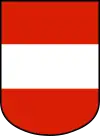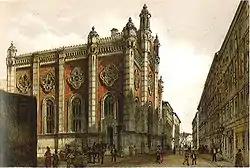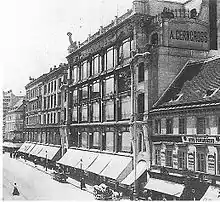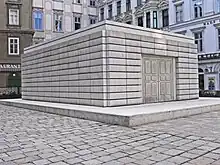| Part of a series on |
| Jews and Judaism |
|---|
|
| History of Austria |
|---|
 |
|
|
The history of the Jews in Vienna, Austria, goes back over eight hundred years. There is evidence of a Jewish presence in Vienna from the 12th century onwards.[1]
At the end of the 19th century and the start of the 20th century, Vienna was one of the most prominent centres of Jewish culture in Europe, but during the period of National-Socialist rule in Austria, Vienna's Jewish population was almost entirely deported and murdered in the Holocaust. Since 1945, Jewish culture and society have gradually been recovering in the city.
History
Middle Ages


Proof exists of a Jewish presence in Vienna since 1194. The first named individual was Schlom, Duke Frederick I’s Münzmeister (master of the mint). In 1238, emperor Frederick II granted the Jews a privilege, and the existence of community institutions such as a synagogue, hospital and slaughterhouse can be proven from the 14th century onwards. Vienna’s city law empowered a special Judenrichter (Judge of the Jews) to adjudicate in disputes between Christians and Jews, but this judge was not empowered to rule in conflicts between two Jewish parties, unless one party filed a complaint with him.
The first Jews lived in the area near the Seitenstettengasse; from around 1280, they also lived around the modern-day Judenplatz. The centre of Jewish cultural and religious life was located here from the 13th to the 15th century, until the Vienna Gesera of 1420/21, when Albert V ordered the annihilation of the city’s Jews.
Early Modern (16th–18th centuries)
In the year 1512, 12 Jewish families lived in Vienna.[1] Although there was a ban on new settlement in place until 1624, this was repeatedly circumvented through the granting of exceptions, to the point that a new cemetery was established in the Seegasse in 1582. Jews’ rights were further restricted in 1637, leading to the second expulsion of Vienna's Jewish population in 1669/70 under Leopold I. The second Ottoman siege of Vienna in 1683 however led to Samuel Oppenheimer’s appointment as a financier to the court; he was also responsible for the restoration of the cemetery. Oppenheimer was able to help Samson Wertheimer from Worms to come to Vienna in 1684. Wertheimer was later named Court Jew, but he could not perform his duties as a Rabbi in Vienna and therefore left for Eisenstadt, part of the Siebengemeinden, where Jews were welcomed under Paul I, 1st Prince Esterházy of Galántha.
From 1736, there was a small Sephardic population in Vienna, which had its own religious community with a synagogue at the time of Maria Theresa. The majority Ashkenazi population only obtained the same status much later under Franz Joseph I.
Influenced by the Enlightenment, emperor Joseph II decreed his Edict of Tolerance, which paved the way for Jewish emancipation. For the first time in history, Jews received certain rights already accorded to Gentiles, and discriminatory laws were struck from the books. They were however still forbidden to form a religious community and to hold religious services in public.
Restoration (19th century)
| Jewish population of Vienna[2][3][4][5] according to census and particular area | |||||||
| Year | total pop. | Jews | Percentage | ||||
|---|---|---|---|---|---|---|---|
| 1857 | 476,220 | 2617 | 1.3 | ||||
| 1869 | 607,510 | 40,277 | 6.6 | ||||
| 1880 | 726,105 | 73,222 | 10.1 | ||||
| 1890 | 817,300 | 99,444 | 12.1 | ||||
| 1890* | 1,341,190 | 118,495 | 8.8 | ||||
| 1900 | 1,674,957 | 146,926 | 8.7 | ||||
| 1910 | 2,031,420 | 175,294 | 8.6 | ||||
| 1923 | 1,865,780 | 201,513 | 10.8 | ||||
| 1934 | 1,935,881 | 176,034 | 9.1 | ||||
| 1951 | 1,616,125 | 9000 | 0.6 | ||||
| 1961 | 1,627,566 | 8354 | 0.5 | ||||
| 1971 | 1,619,855 | 7747 | 0.5 | ||||
| 1981 | 1,531,346 | 6527 | 0.4 | ||||
| 1991 | 1,539,848 | 6554 | 0.4 | ||||
| 2001 | 1,550,123 | 6988 | 0.5 | ||||
| * = after expansion of Vienna | |||||||
In 1824, Michael Lazar Biedermann's recommendation led to Rabbi Isaak Mannheimer being brought from Copenhagen to Vienna. As there was still officially no Jewish religious community, Mannheimer was employed as the “Director of the imperially approved public Israelite religious school of Vienna”. Mannheimer realised cautious reforms in Vienna without provoking a schism within the Jewish population, such as those that occurred in the majority of Jewish communities in Europe in the 19th century. With Lazar Horowitz, who was summoned to Vienna as a Rabbi in 1828, Mannheimer agitated for the abolition of the discriminatory Jewish Oath. The merchant Isaak Löw Hofmann also played a leading role in Vienna's Jewish community from 1806 until his death in 1849.
On 12 December 1825, Mannheimer laid the foundation stone for the Stadttempel in the Seitensteingasse. The synagogue, which had been designed by Joseph Kornhäusel, was sanctified by Mannheimer on 9 April 1826. In the same year, Salomon Sulzer from Hohenems was appointed hazzan at the synagogue, where he served for 56 years.
The Revolution of 1848 was seen by many Jewish intellectuals as a welcome opportunity to agitate for the emancipation of their community. For the first time in their history, Jews were accorded the unrestricted right to reside and to practice their religion throughout Austria in the 1867 constitution. As a consequence, the Jewish community grew rapidly: in 1860, the Jewish community in Vienna numbered 6,200; in 1870, that number had already risen to 40,200, and at the turn of the century, to 147,000. Vienna's 2nd district, Leopoldstadt, developed into the centre of Vienna's Jewish life at this time. The Jewish population in this area of the city soon represented half of the entire population in the district. The neighbouring districts of Brigittenau (which was divided from Leopoldstadt in 1900) and Alsergrund equally had high proportions of Jews. The Jews that lived in these areas made up the majority of Vienna's Jewish population and belonged for the most part to the lower or middle classes – they were manual labourers, craftsmen, small-scale businessmen (e.g. café owners) and traders. Wealthy Jews lived for the most part in the villa suburbs of Döbling and Hietzing, and in the city centre, the Innere Stadt.
Theodor Herzl responded to the increasing spread of Antisemitism during this period with the creation of political Zionism. At the same time however, the Jewish community was led predominantly by assimilated Jews.
Collapse of the Habsburg monarchy and First Republic (1910s–1930s)
| Jewish contributions to Vienna's economy (1934)[6] | |||||||
| Percentage of all activity attributable to Viennese citizens of Jewish origin | |||||||
|---|---|---|---|---|---|---|---|
| Doctors | 51.6% | ||||||
| Pharmacists | 31.5% | ||||||
| Credit bureaus | 82.0% | ||||||
| Driving schools | 13.0% | ||||||
| Bakers and bread makers* | 60.0% | ||||||
| Banks | 75.0% | ||||||
| Drug stores | 26% | ||||||
| Butchers | 9% | ||||||
| Photographers | 34% | ||||||
| Hairdressers | 9.4% | ||||||
| Garages | 15.5% | ||||||
| Jewellers | 40% | ||||||
| Café operators | 40% | ||||||
| Cinemas | 63% | ||||||
| Furriers | 67.6% | ||||||
| Milliners | 34% | ||||||
| Opticians | 21.5% | ||||||
| Traders of leather goods | 25% | ||||||
| Lawyers | 85.5% | ||||||
| Advertising bureaus | 96.5% | ||||||
| Pubs | 4.7% | ||||||
| Locksmiths | 5.5% | ||||||
| Shoemakers | 70% | ||||||
| Tinsmiths | 20% | ||||||
| Textile branch | 73.2% | ||||||
| Watchmakers | 32% | ||||||
| Dental technicians | 31% | ||||||
| Candy stores | ≤ 70% | ||||||
| Scrap metal and metal dealers | ≤ 100% | ||||||
| Petrol and oil dealers | 70% | ||||||
| Poultry dealers | 60% | ||||||
| Wood and paper dealers | ≤ 70% | ||||||
| Furniture traders and producers | 85% | ||||||
| Radio dealers | ≤ 80% | ||||||
| Wine dealers | 73.6% | ||||||
| * as well as the entire production of bread | |||||||




After the outbreak of World War I and the first Austrian defeats on the eastern front, an exodus of 350,000 refugees began in the eastern regions of the empire (Galicia). Amongst the refugees were some 50,000 (according to the police) to 70,000 (according to the Arbeiterzeitung newspaper) Jews, who all arrived at Vienna's northern railway station in Leopoldstadt.
Although around half of these new arrivals returned to their homes once the situation had calmed down on the eastern front,[7] the entire Jewish community in Vienna and its relations with Vienna's Christian population were put to the test by these events. The refugees were poverty-stricken, but work was hard to come by and factories were unwilling to employ the refugees. The situation has been described thus: “While the Germans were condemning the Jews in the east to forced labour, the Austrians were condemning them to forced unemployment”.[7] Many of the refugees tried to earn their daily bread as peddlers or salesmen, and many charity organisations sprung up to coordinate clothes donations and other campaigns, but the “Ostjuden” (Eastern Jews) were the victims of many negative prejudices and because of their poverty were more frequently the targets of antisemitic attacks than wealthy assimilated Jews. It was not made easy for them to establish themselves in Vienna.
With the fall of the Habsburg Monarchy, Jews could move freely throughout Austria-Hungary. The community in Vienna grew again; it remained approximately the same size until the start of the persecution of Jews in the 1930s. At this time, Vienna's Jews were divided into two groups. On the one hand, there were the Jews who had either lived for a long time in Vienna or who had been born there and who assimilated into Christian society. On the other hand, there were Orthodox Jews, who wished to live in line with traditional beliefs and practices. The community's voting habits also reveals a division; while the majority, made up for the most part of assimilated Jews, voted for the social democrats, others voted for Jewish parties, which disputed elections both in the empire and in the First Republic and which concentrated their campaign advertising on fighting the social democrats for votes. Over time, almost all Jews came to vote for the social democrats, because the Jewish parties were seen as not strong enough, while all other parties were antisemitic and refused to accept Jewish members.[7]

Antisemitism became ever more pronounced during this period. In Jewish quarters, in particular in Leopoldstadt, antisemitic organisations distributed their flyers and newspapers aimed at turning the Christian population against their Jewish neighbours. A protest at the Praterstern organised by socialists and communists against such provocation ended in violence. When the German-nationalist Josef Mohapl was stabbed to death by an apolitical attacker who already had a criminal record, right-wing newspapers dubbed this the “Christian pogrom in Leopoldstadt”, and from this moment onwards, Nazi hooligans were to be seen in Leopoldstadt. One of the first attacks on prominent establishments that these groups instigated was the destruction of the well-known “Café Produktenbörse” in December 1929. The attack on a prayer room in the Café Sperlhof in 1932 was particularly violent; praying Jews were beaten and the attackers laid waste to the building.[7]
Many Jews joined socialist and/or Zionist (youth) organisations, the largest of which were Hashomer Hatzair, Poale Zion and the Jewish Socialist Workers’ Youth. In the 1930s, some socialist, Jewish and Zionist movements united in committees for action, to organise street patrols and to take action against “Hakenkreuzler” (thugs bearing the swastika), who were attacking Jews. The first such group was the “Jüdische Selbstwehr” (Jewish Self-Defence). The paramilitary organisation Betar also had members in Vienna.[7]
After a century of progress towards Jewish emancipation, antisemitic attacks encouraged by the Christian Social Party, the Greater German People's Party and the Nazis became more common between the two World Wars. Hugo Bettauer was amongst those who recognised the signs of the time. The film “The City Without Jews” is based on his novel with the same title.
The Holocaust (1938–1945)

Just one day after the Anschluss in March 1938, Jews were being harassed in Vienna. They were driven through the streets of Vienna, their homes and shops were plundered and the process of Aryanisation began. These events reached their climax in the Kristallnacht pogrom of 9–10 November 1938. All synagogues and prayer houses in Vienna were destroyed – the Stadttempel was the sole survivor because its location in a residential area prevented it from being burned down. Most Jewish shops were plundered and then closed down; over 6000 Jews were arrested in this one night, the majority were deported to the Dachau concentration camp in the following days. The Nuremberg Laws applied in Austria from May 1938; they were reinforced with innumerable anti-semitic decrees. Jews were gradually robbed of their freedoms, were blocked from almost all professions, were shut out of schools and universities, and were forced to wear the Yellow badge.
The Nazis dissolved Jewish organisations and institutions, hoping to force Jews to emigrate. Their plans succeeded – by the end of 1941, 130,000 Jews had left Vienna, 30,000 of whom went to the USA. They left behind all of their property, but were forced to pay the Reich Flight Tax, a tax on all émigrés from the Third Reich; some received financial support from international aid organisations so that they could pay this tax. Following the Wannsee Conference in January 1942, where the Nazis resolved to completely annihilate the Jewish population, the majority of the Jews who had stayed in Vienna became victims of the Holocaust. Of the more than 65,000 Viennese Jews who were deported to concentration camps, only a few more than 2000 survived.
Second Republic (Since 1945)

After World War II, it took a long time for Austria to come to a clear position with regard to its part of the responsibility for the horrors of the "Third Reich". In the 1980s, a shift in thinking took place that led to the declaration on the part of the Austrian government in June 1991, in which Chancellor Vranitzky made the first explicit statement in parliament concerning the participation of Austrian citizens in the crimes of Nazi Germany.
Vienna's Jewish population numbered more than 201,000 before 1938. In 1946, just 4,000 Jews remained, many of whom emigrated in the following years. Meanwhile, the Jewish population in Germany actually grew as a result of emigration from Eastern Europe at this time.[8] At the end of the 1990s, there were barely more than 7000 registered members of Vienna's Jewish community. Many of the Jews who live in Vienna today came to the city as refugees from Eastern Europe to begin a new life in the Austrian capital. Immigrants of Jewish origin from the lands of the former Soviet Union in particular have strengthened the ranks of Vienna's Jewish population. In 1992, a Sephardic Centre was officially opened in the city, while in 1994, the Psychosocial Centre Esra (Help) was established, and in 1999, the new school building of the Ronald S. Lauder Foundation opened in the Augarten. In 2000, the Judenplatz Holocaust Memorial, designed by Rachel Whiteread, was unveiled, and a Museum of Jewish history, life and religion was also opened at the Judenplatz.
In autumn 2008, the Zwi Perez Chajes school moved from the Castellezgasse to the Simon-Wiesenthal-Gasse next to the Messe Wien at the Prater. The school thus forms part of a complex including a Jewish kindergarten, primary school, and grammar school for around 600 children, and is located near the Hakoah Vienna sport club, which was re-opened in March 2008, an education centre, and an old people's home.[9]
The 2001 census in Austria counted 8140 Jews in Austria, of which 6988 were living in Vienna.[10] The Israelitische Kultusgemeinde Wien, however, believes that there are around 15,000 Jews in Austria;[11] some sources speak of as many as 20,000.[9]
Leopoldstadt continues to represent a centre of Jewish life in Vienna. The proportion of the population of Jewish religion is above average, at 3.1%. There are eight Ashkenazi and three Sephardic synagogues or prayer houses in this district of the city,[12] seven Jewish educational institutions,[13] as well as numerous kosher shops, bakeries and restaurants.
Synagogues

Over the centuries, 93 synagogues have been founded in Vienna. The only synagogue to have survived the Kristallnacht pogrom is the Stadttempel. Some new synagogues and prayer rooms have since been established.
See also
References
- 1 2 "The Jewish Community of Vienna". The Museum of the Jewish People at Beit Hatfutsot.
- ↑ census 1890, 1900, 1910 of the K. K. Statistischen Central-Kommission and census 1934 and Statistisches Jahrbuch der Stadt Wien für das Jahr 1910, in: Anson Rabinbach: The Migration of Galician Jews to Vienna. Austrian History Yearbook, Volume XI, Berghahn Books/Rice University Press, Houston 1975, S. 48 (in German)
- ↑ Statistisches Jahrbuch der Stadt Wien 1930–1935 (Neue Folge. 3. Band) published by Magistratsabteilung für Statistik. Contains figures of 1910, 1923 und 1934. (in German)
- ↑ Österreichische Historikerkommission: Schlussbericht der Historikerkommission der Republik Österreich. Band 1. Oldenbourg Verlag, Wien 2003, S. 85–87 (Ergebnis der Volkszählung 1934) (in German)
- ↑ Statistik Austria: Bevölkerung nach dem Religionsbekenntnis und Bundesländern 1951 bis 2001 (accessed 15 January 2009) (in German)
- ↑ Georg Glockemeier: Zur Wiener Judenfrage. Verlag Günther, Leipzig & Wien 1936. (Auf Grundlage der Volkszählung 1934.) (in German)
- 1 2 3 4 5 Ruth Beckermann: Die Mazzesinsel. In: Ruth Beckermann (Hrsg.): Die Mazzesinsel – Juden in der Wiener Leopoldstadt 1918–38. Löcker, Wien 1984, ISBN 978-3-85409-068-7, S. 16f. (in German)
- ↑ Ariel Muzicant: Österreich ist anders, 12. Mai 2005. In: Der Standard, 4. Mai 2005 (in German)
- 1 2 Marijana Milijković: Von einer Blüte ist keine Rede – Dennoch tut sich was in der jüdischen Gemeinde: Der Campus im Prater eröffnet. Der Standard, 12. September 2008, S. 2 (in German)
- ↑ Volkszählung der Statistik Austria, 2001 (in German)
- ↑ Ariel Muzicant: Österreich ist anders. 12. Mai 2005. In: Der Standard, 4. Mai 2005 (in German)
- ↑ IKG Wien: Synagogen in Wien Archived 2009-04-29 at the Wayback Machine accessed 31 January 2009 (in German)
- ↑ IKG Wien: Jüdische Schulen und Bildungsstätten Archived 2009-04-29 at the Wayback Machine, accessed 31 January 2009 (in German)
External links
- 150 Jahre IKG: Rede von Ariel Muzicant anlässlich des 150-jährigen Bestehens der IKG Wien (in German)
- Gedenk- und Aufklärungsarbeit der Stadt Wien (in German)
- Martha Keil – Geschichte der Juden in Wien (in German)
- Das österreichische Judentum (in German)
- The Jewish Community of Vienna - The Museum of the Jewish People at Beit Hatfutsot (in English or Hebrew)
Further reading
- Ruth Beckermann: Die Mazzesinsel – Juden in der Wiener Leopoldstadt 1918–38. Löcker, Wien 1984, ISBN 978-3-85409-068-7. (in German)
- Michaela Feurstein, Gerhard Milchram: Jüdisches Wien. Mandelbaum Verlag, Wien 2007, ISBN 978-3-85476-225-6. (in German)
- Felicitas Heimann-Jelinek; Gabriele Kohlbauer-Fritz (Red.): Jüdischer Stadtplan Wien. Einst und jetzt. Stadtplan. Hrsg.: Jüdisches Museum der Stadt Wien. Freytag-Berndt und Artaria, Wien 1993. (in German)
- János Kalmár, Alfred Stalzer: Das Jüdische Wien. Pichler, Wien 2000, ISBN 3-85058-182-9. (in German)
